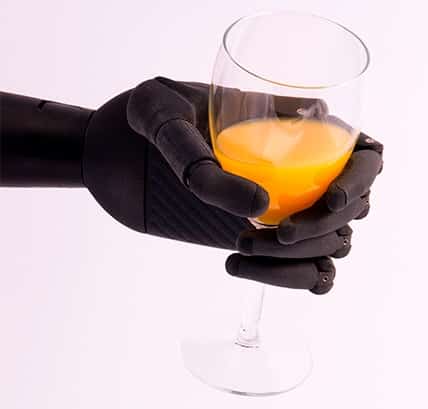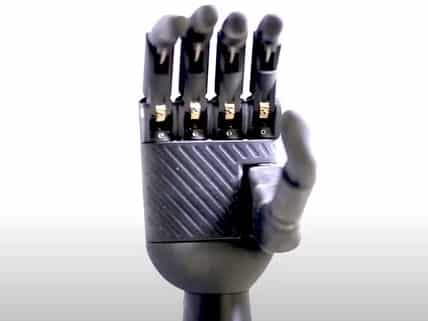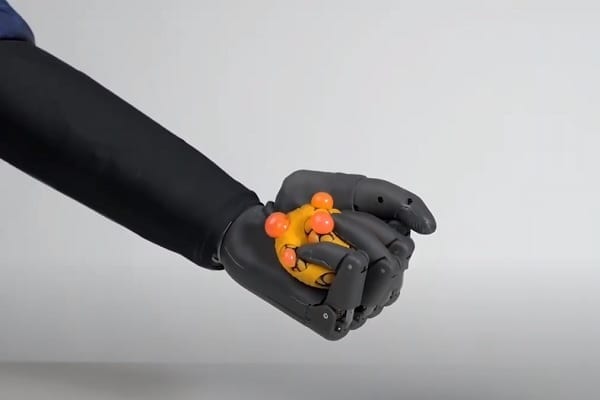The Zeus Hand is a relatively new addition to the bionic-hand market but it appears to be backed by solid technology and a promising young company.
What’s On This Page?
- A Quick Look at the Zeus Hand
- Grip Patterns & Control System
- Thumb Rotation
- Proportional Speed Control
- Sensory Feedback
- Wrist Design
- Lift Capacity & Grip Strength
- Durability
- Water and Dust Resistance
- Glove Options
- Batteries
- User Software
- Suitability for Above-the-Elbow Solutions
- Price
- Availability
- Warranty
- User Feedback Survey & Results
- Considerations Before Buying a Zeus Hand
- Related Information
A Quick Look at the Zeus Hand
This first short video shows Zeus being used in a variety of tasks around the house:
This next video shows Zeus participating in all the steps required to make a meal. Notice how the wearer uses his Zeus to turn the door key and also how he holds the knife:
Now that you’ve seen Zeus in action, let’s dive into some of its more interesting features.
Zeus Hand Key Features
Grip Patterns & Control System
In theory, the number and types of tasks that a bionic hand can perform depend on the number of grips that it supports. In the current bionic arm/hand market, this ranges from a low of 6 to a high of 36.
Numerically, Zeus falls in the middle of the pack with 12 standard grips plus 2 more that are user-configurable. Here is a quick look at some of its core grips:
There is a reason that we like to focus on core grips. According to multiple scientific studies, users only use a few grips, so having a high number of grips is not that important. What’s important is how well a bionic hand performs its core grips.
In this regard, Zeus offers a few valuable enhancements. First, it automatically detects the thumb position and limits the available grips accordingly. Also, as each finger closes, it stalls as soon as it meets a certain level of resistance. This allows Zeus to intuitively conform to the shape of each object that it grasps.

For example, when picking up a wine glass, the thumb, index finger, and middle finger all stop closing once they meet the resistance of the glass bowl. But the ring finger and pinky continue closing until they encounter the stem. This mirrors the way natural hands work and results in better, more adaptable grips.
Of course, none of this matters if a user can’t precisely control a bionic hand. As with most bionic hands, Zeus is controlled using myoelectric signals. Historically, this type of control system can generate a significant number of errors in real-life circumstances. For example, it can be negatively impacted by different arm positions, changes in temperature, and changes in the size and shape of the residual limb throughout the day. For more information, see our article, Finding the Right Myoelectric Control System.
Zeus uses the Element Sensor System from Infinite Biomedical Technologies (IBT) for its myoelectric control, which offers several benefits, including:
- digital signal processing;
- improved noise reduction;
- a lower physical profile;
- wireless setup and adjustments.
We think this is a wise choice because IBT specializes in myoelectric control, so Zeus will effectively benefit from IBT’s advances in this area over time.
Thumb Rotation
The Zeus Hand does not come with an electronically positioned thumb. The thumb does open and close electronically. It also has a built-in sensor to detect its position, which it uses to determine available grips, but users must manually rotate the thumb into an opposing or lateral position.
This is not a major drawback. Myoelectric hands typically require some form of preparation before performing a task, such as selecting an appropriate grip. In most instances, users will intuitively rotate Zeus’s thumb into position with their free hand. However, there are some cases where this is not convenient, such as when both hands are needed for a task.
In Zeus’s case, this is a trade-off for its grip strength and robustness. To rotate Zeus’s thumb would require a heavier motor, which in turn would increase the hand’s weight. It would also complicate the grip change mechanism, which Zeus has tried to make as easy as possible for users.
However, in a market where several hands now offer electronic thumb rotation, we do view this as a slight competitive disadvantage.
Proportional Speed Control
As with most myoelectric hands, the Zeus Hand offers proportional speed control. This allows the user to change the grip speed and strength just by controlling the strength of muscle signals.
Sensory Feedback
To our knowledge, the Zeus Hand does not offer any form of sensory feedback to the end-user.
Wrist Design
The Zeus Hand comes with an industry-standard Quick Disconnect Wrist. There do not appear to be any other wrist options available from Aether Biomedical at this time.
Lift Capacity & Grip Strength
Zeus offers a lift capacity of 35 kgs, which puts it in the upper-middle tier of the industry. It also offers a grip force of 152 newtons, which is the most we’ve seen for any bionic hand. By comparison, natural hands exert roughly 70 newtons of force for typical daily activities.
Durability

The Zeus Hand offers several features to enhance its durability. Its fingers are compliant, which reduces the risk of finger breakage. Its palm uses a combination of hard and soft material for reduced weight and lateral shock absorption. And if you do happen to damage the hand, its modular design makes for a fast and easy repair that can be performed at a local service center.
That having been said, Zeus is designed for mild to moderate activities. This is true of almost every modern bionic hand — Aether Biomedical just states it upfront.
Water and Dust Resistance
We do not have an official IP rating for the Zeus Hand, but we do know from its user guide that it is not waterproof or dustproof.
Glove Options
Aether Biomedical does not offer any glove options for Zeus.
Batteries
The standard Zeus kit comes with thin, flexible battery cells called “FlexCells”. These are made by Infinite Biomedical Technologies (IBT). The batteries should last for a full day of typical activities. Once completely drained, the batteries require 3.5 hours to fully charge.
The expected service life for the batteries is two years.
User Software
Aether Biomedical does not provide software for end-users. It does, however, provide software for clinicians to configure the Zeus.
Suitability for Above-the-Elbow Solutions
Zeus is a component bionic hand. This means that it can be used with a fitted shell for below-the-elbow solutions, or in combination with bionic elbows and/or shoulders for above-the-elbow solutions.
Price
According to our information, the Zeus Hand sells for between $20,000 and $30,000 US for a typical below-the-elbow solution, including all prosthetist fees.
For a complete list of prices for other bionic hands, please see our Bionic Hand Price List.
Availability
Zeus is currently available in the USA, Europe, Russia, India.
Warranty
The Zeus Hand comes with a 24-month manufacturer’s warranty. There does not appear to be an option to pay to extend this warranty.
To maintain the warranty, Zeus must be serviced by a trained clinician every six months.
User Feedback Survey & Results
Survey
Are you currently using the Zeus Hand or have you used it in the past?
If so, why not help others by sharing your experiences in this quick survey:
Results
We do not yet have a sufficient number of survey participants to publish fair and accurate results for the Zeus Hand.
As soon as we do, we’ll update this section.
Considerations Before Buying the Zeus Hand
Zeus appears to be a solid competitor in the bionic hand market. Additionally, the company’s founder and CEO has been as open and transparent with us as we could ask — a good sign that he understands the need to make the bionic limb industry more patient centric.
Having said all that, we rely mostly on the results of our User Satisfaction Surveys to shape our final opinion of any bionic device, and we’ve not yet received enough responses on the Zeus to do so.
Related Information
For a list of competitor devices, see all bionic hands.
For a complete description of all current upper-limb technologies, devices, and research, see our comprehensive guide.
Click here for more information on Aether Biomedical.
